Laparoscopic Open Access Technique
The Open Access Technique was developed by Hasson in 1974. The choice of the site may be based on the surgeon’s preference or the presence of a previous regional incision that may have adhesions. Hasson trocar is used in open technique which is available both in disposable and reusable models. The open-access technique is like mini-laparotomy and the cannula is introduced inside. Hasson’s technique involves direct open visualization of the tissues at every layer until the peritoneum is opened, followed by placement of anchoring sutures in the fascia to secure a conical collar. The trocar is then placed through the collar to establish pneumoperitoneum and access. Disadvantages include persistent uncontrolled carbon dioxide leakage in many cases, increased incision size, and increased time for placement. This technique generally adds to the length of the procedure, taking longer to perform at the beginning and the end of the procedure compared with a closed Veress needle technique. Even though the Hasson technique is most commonly used in the periumbilical region, this method can be used anywhere on the abdominal wall and is particularly useful when there is a concern for abdominal wall adhesions in a patient with a prior laparotomy.
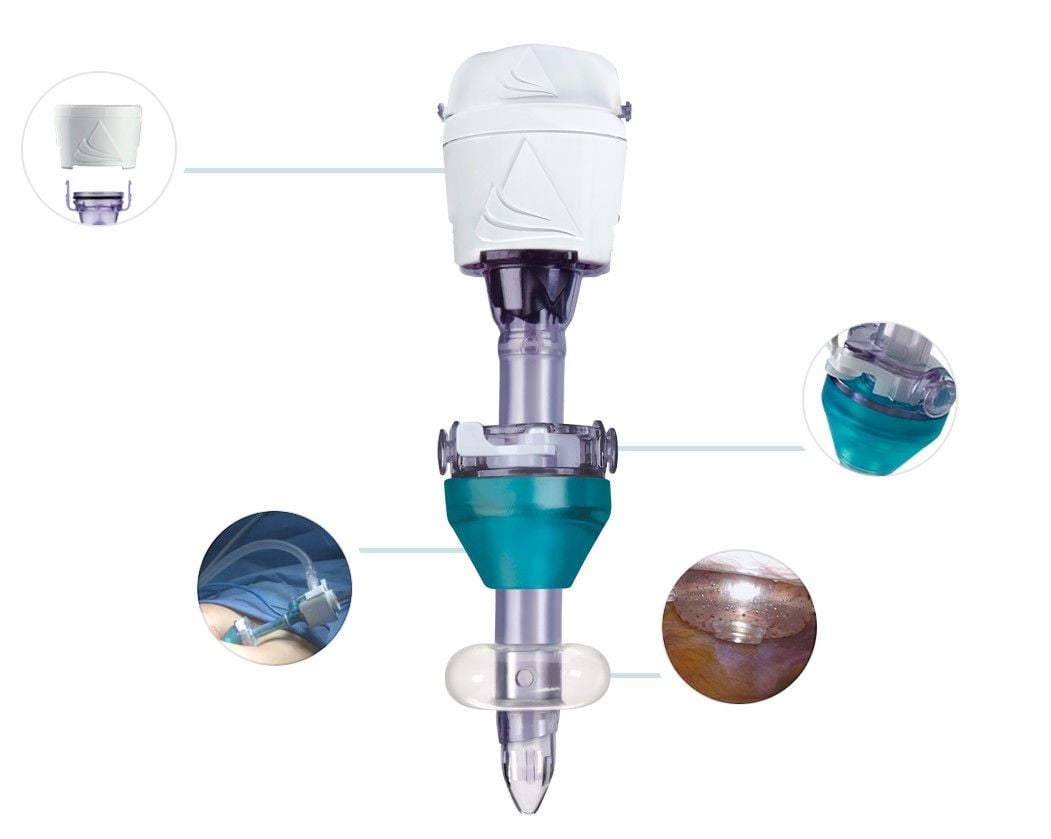
Disposable Hasson Trocar
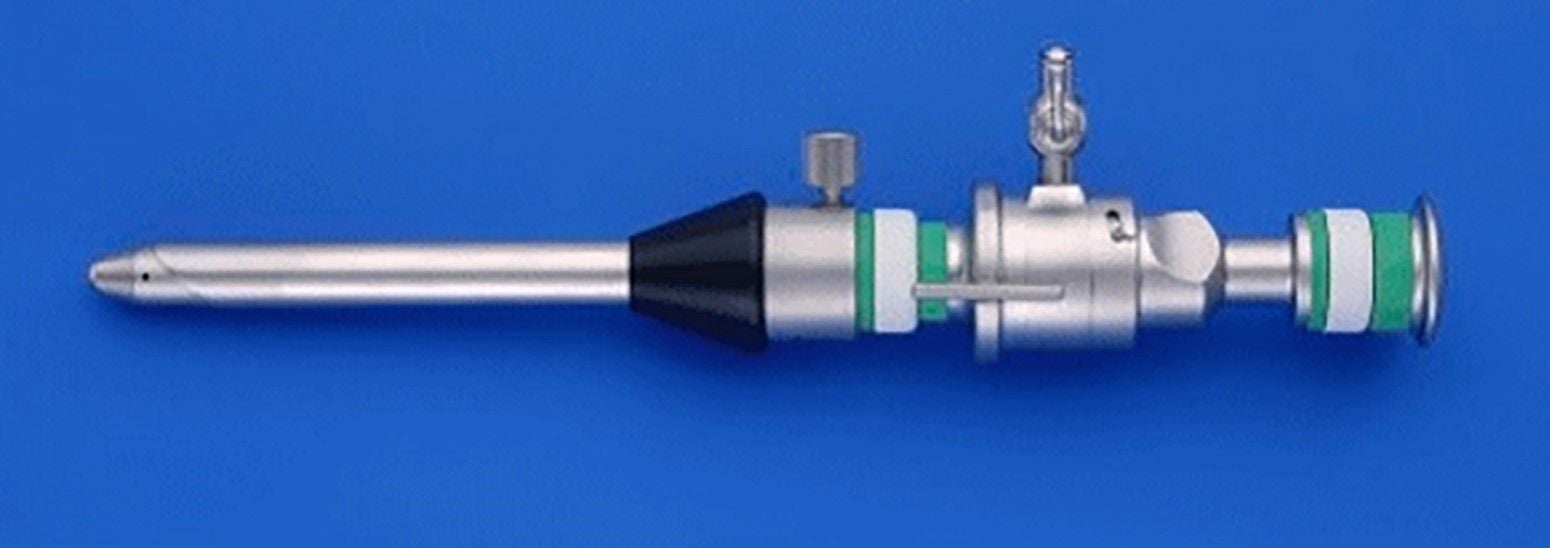
Reusable Hasson Trocar
In this, there is a direct entry by open technique, without creating pneumoperitoneum and the insufflator is connected once blunt trocar is inside the abdominal cavity under direct vision. There are various ways of open access like Hasson’s technique, Scandinavian technique, and Fielding technique.
Some surgeons and gynecologists practice blind trocar insertion without pneumoperitoneum. The incidence of injury due to this type of access is much higher. This type of direct trocar entry is practiced by gynecologists for sterilization. Sterilization may be performed because in multipara patients the lower abdominal wall is lax; making the fascia thinner and easy elevation by hand is possible. Bleeding due to accidental damage to a major vessel during this initial stage is one of the most dangerous complications of laparoscopic surgery.
The Hasson trocar system was initially developed for laparoscopy in patients who have had a previous laparotomy. After seeing the benefit of the open access technique, many surgeons started using open-access technique routinely in all their patients. An access wound was made using traditional open techniques and the Hasson trocar and cannula were designed to both fix the port and seal this larger wound around the port. It requires the use of sutures to prevent slippage of the port. This involved making a small entry wound directly through the scar tissue of the umbilicus and then dilating this up by passage of a blunt, preferable conically tipped trocar and cannula.
Steps of Open Access Technique
A transverse incision is made in the sub umbilical region and the upper skin flap is retracted with an Allis forceps. The lower flap is retracted using a small right-angled retractor. Subcutaneous tissue is dissected till the linea alba and the rectus sheath is visualized. Stay sutures are taken on either side of the midline.
• Make a transverse or longitudinal incision in the skin just below the umbilicus
• Stay suture is given both the end of the transverse incision.
• Both the stays are pulled up to make a bridge like the elevation of the rectus.
• Rectus sheath is incised in the midline along the line of linea alba pointing upwards. The incision should not penetrate the peritoneum; otherwise, any adhesion with the peritoneum may be punctured.
• Incise the fascia until a small amount of preperitoneal fat is identified. Place stay sutures in the fascial edges.
• The stay sutures aid with retraction of the abdominal wall and can be used to secure the port to the fascia, preventing its displacement during the surgery.
• A hemostat is stabbed into the peritoneum while holding the stays up.
• The give-way of the peritoneum can be felt as peritoneum is perforated and then the hemostat is opened to widen the opening.
• Open the peritoneum bluntly, sweep the underside of the abdominal wall with the index finger to clear omentum or bowel, and confirm the absence of adhesions in the region of the incision.
• Surgeon should insert his finger to feel all around inside the abdominal cavity to feel any possible adhesion.
• Small tiny adhesion felt can be broken with a gentle sweeping movement of the finger.
• Blunt trocar-cannula should be inserted for the first port after visualizing the intraperitoneal viscera.
• Care is taken not to make a big incision; cannula dilates the smaller incision to give an airtight fit.
• If the incision is big, the rectus string should be tightened to hold the port in the proper position.
• Attach the gas (typically carbon dioxide) to the port and insufflate the abdomen. Fast insufflation should be avoided to prevent Vasovagal shock.

Skin Incision for Open Technique
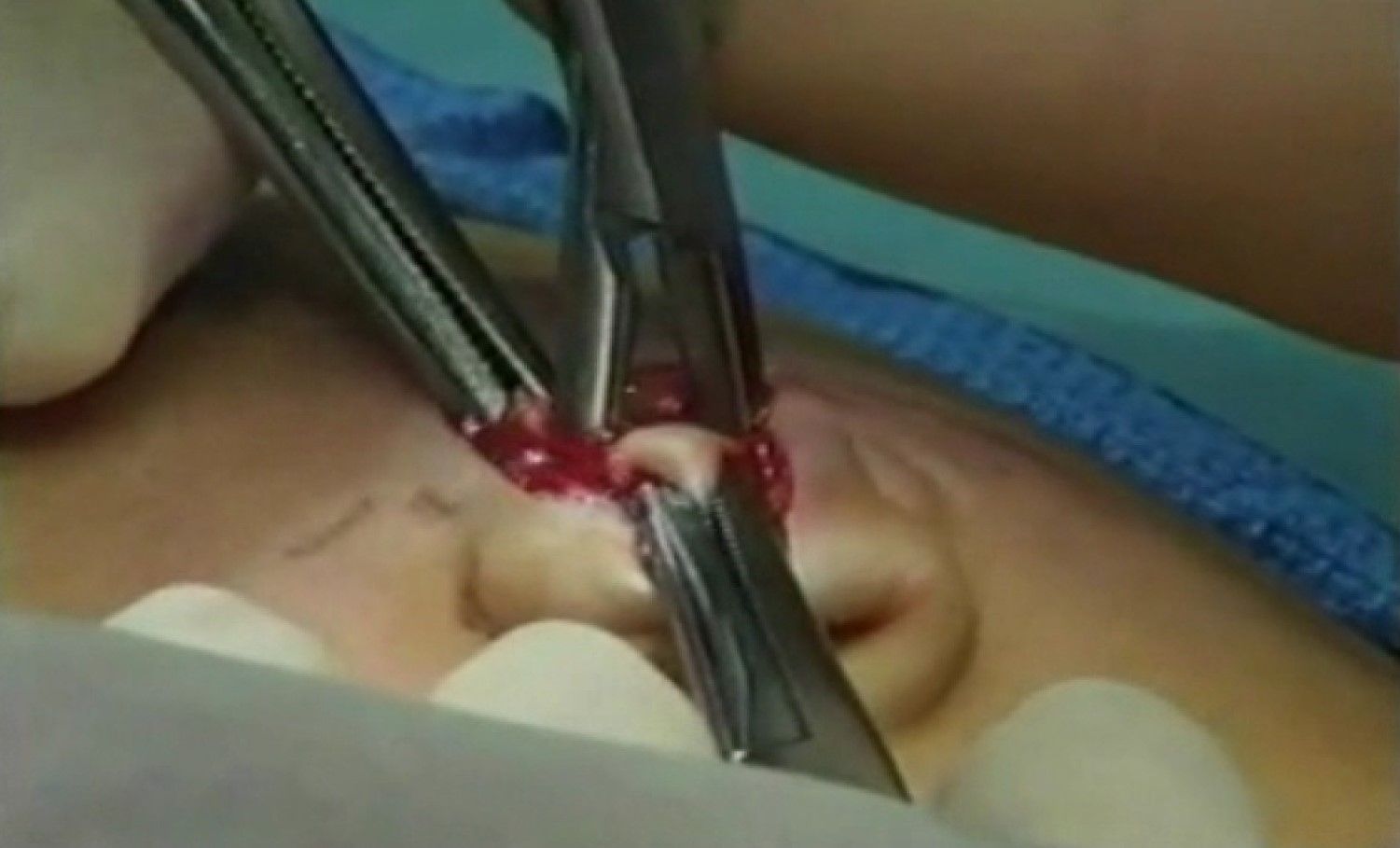
The hemostat is stabbed into the peritoneum
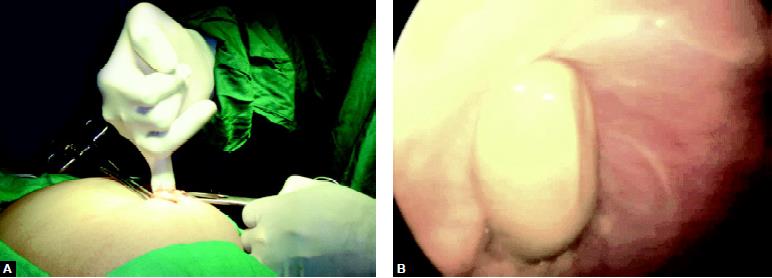
Finger insertion after open access will confirm adhesion
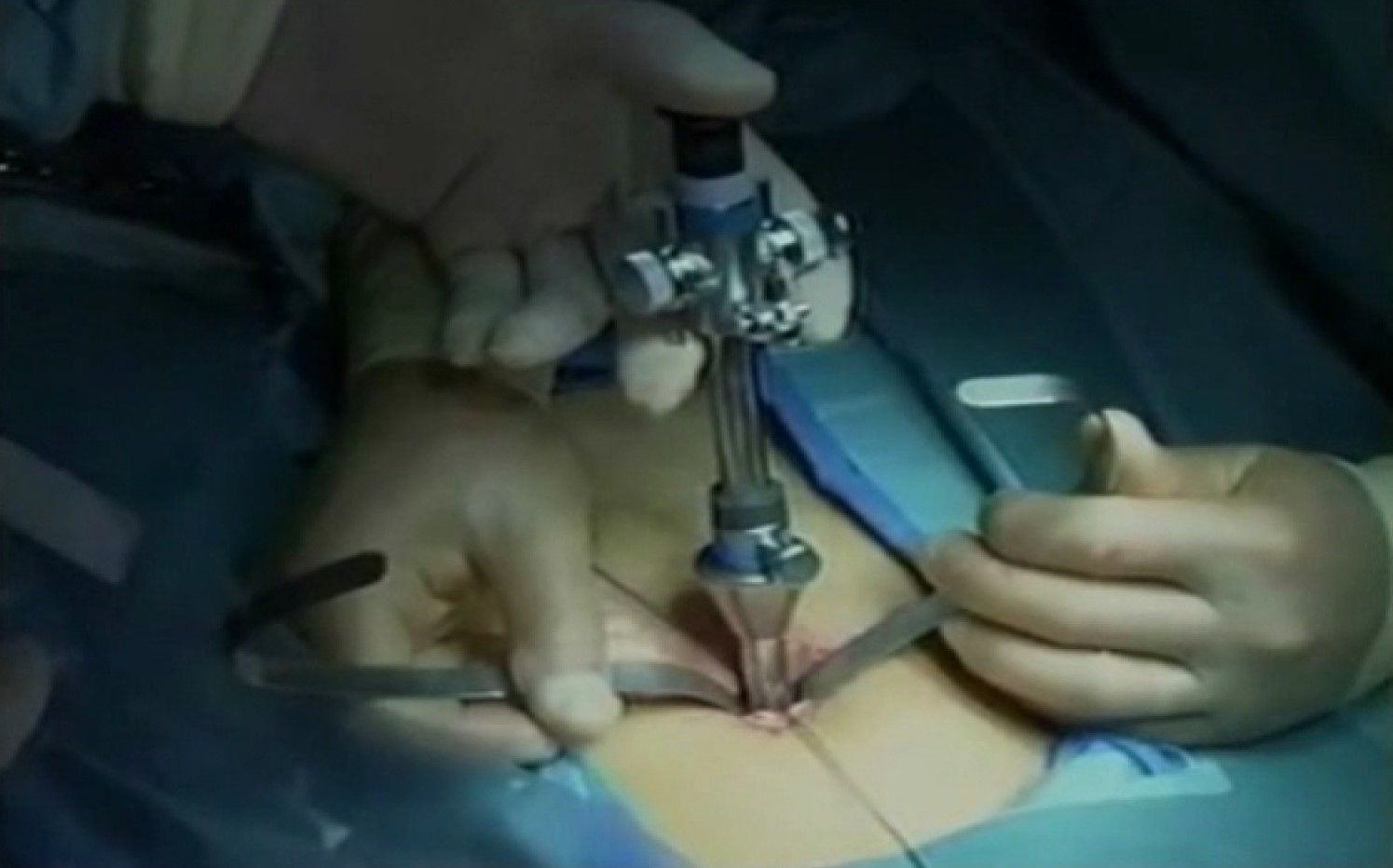
Introduction of Hasson Trocar

Fixation of Hasson Trocar
Advantages of Open Technique
• Definite, small risk of injury with blind Veress needle technique irrespective of experience.
• Particularly useful in previous abdominal surgery or underlying adhesions.
• The incidence of injury to adhesion, although not eliminated, is significantly reduced by entry into the peritoneal cavity under direct vision.
• There is a decreased risk of injury to the retroperitoneal vessels. The trocar is blunt, and the angle of entry allows the surgeon to maneuver the cannula at an angle, which avoids viscera, while still assuring peritoneal placement.
• The risk of extraperitoneal insufflation is eliminated. Placement under direct vision ensures that the insufflation of gas is actually into the peritoneal cavity.
• The likelihood of hernia formation is decreased because the fascia is closed as part of the technique.
• Increasing the number of surgeons performing laparoscopy without experience and in these group open technique may be easy.
• Useful in muscular man and children with a strong abdominal wall.
• Useful for gynecologists or surgeons lacking enough upper arm strength to elevate the abdominal wall of patient.
• An open technique, which involves creating a mini-laparotomy into which a special cannula is inserted, may be adopted. This procedure has its own complications and requires skilled execution.
The Open Access Technique was developed by Hasson in 1974. The choice of the site may be based on the surgeon’s preference or the presence of a previous regional incision that may have adhesions. Hasson trocar is used in open technique which is available both in disposable and reusable models. The open-access technique is like mini-laparotomy and the cannula is introduced inside. Hasson’s technique involves direct open visualization of the tissues at every layer until the peritoneum is opened, followed by placement of anchoring sutures in the fascia to secure a conical collar. The trocar is then placed through the collar to establish pneumoperitoneum and access. Disadvantages include persistent uncontrolled carbon dioxide leakage in many cases, increased incision size, and increased time for placement. This technique generally adds to the length of the procedure, taking longer to perform at the beginning and the end of the procedure compared with a closed Veress needle technique. Even though the Hasson technique is most commonly used in the periumbilical region, this method can be used anywhere on the abdominal wall and is particularly useful when there is a concern for abdominal wall adhesions in a patient with a prior laparotomy.

Disposable Hasson Trocar

Reusable Hasson Trocar
In this, there is a direct entry by open technique, without creating pneumoperitoneum and the insufflator is connected once blunt trocar is inside the abdominal cavity under direct vision. There are various ways of open access like Hasson’s technique, Scandinavian technique, and Fielding technique.
Some surgeons and gynecologists practice blind trocar insertion without pneumoperitoneum. The incidence of injury due to this type of access is much higher. This type of direct trocar entry is practiced by gynecologists for sterilization. Sterilization may be performed because in multipara patients the lower abdominal wall is lax; making the fascia thinner and easy elevation by hand is possible. Bleeding due to accidental damage to a major vessel during this initial stage is one of the most dangerous complications of laparoscopic surgery.
The Hasson trocar system was initially developed for laparoscopy in patients who have had a previous laparotomy. After seeing the benefit of the open access technique, many surgeons started using open-access technique routinely in all their patients. An access wound was made using traditional open techniques and the Hasson trocar and cannula were designed to both fix the port and seal this larger wound around the port. It requires the use of sutures to prevent slippage of the port. This involved making a small entry wound directly through the scar tissue of the umbilicus and then dilating this up by passage of a blunt, preferable conically tipped trocar and cannula.
Steps of Open Access Technique
A transverse incision is made in the sub umbilical region and the upper skin flap is retracted with an Allis forceps. The lower flap is retracted using a small right-angled retractor. Subcutaneous tissue is dissected till the linea alba and the rectus sheath is visualized. Stay sutures are taken on either side of the midline.
• Make a transverse or longitudinal incision in the skin just below the umbilicus
• Stay suture is given both the end of the transverse incision.
• Both the stays are pulled up to make a bridge like the elevation of the rectus.
• Rectus sheath is incised in the midline along the line of linea alba pointing upwards. The incision should not penetrate the peritoneum; otherwise, any adhesion with the peritoneum may be punctured.
• Incise the fascia until a small amount of preperitoneal fat is identified. Place stay sutures in the fascial edges.
• The stay sutures aid with retraction of the abdominal wall and can be used to secure the port to the fascia, preventing its displacement during the surgery.
• A hemostat is stabbed into the peritoneum while holding the stays up.
• The give-way of the peritoneum can be felt as peritoneum is perforated and then the hemostat is opened to widen the opening.
• Open the peritoneum bluntly, sweep the underside of the abdominal wall with the index finger to clear omentum or bowel, and confirm the absence of adhesions in the region of the incision.
• Surgeon should insert his finger to feel all around inside the abdominal cavity to feel any possible adhesion.
• Small tiny adhesion felt can be broken with a gentle sweeping movement of the finger.
• Blunt trocar-cannula should be inserted for the first port after visualizing the intraperitoneal viscera.
• Care is taken not to make a big incision; cannula dilates the smaller incision to give an airtight fit.
• If the incision is big, the rectus string should be tightened to hold the port in the proper position.
• Attach the gas (typically carbon dioxide) to the port and insufflate the abdomen. Fast insufflation should be avoided to prevent Vasovagal shock.

Skin Incision for Open Technique

The hemostat is stabbed into the peritoneum

Finger insertion after open access will confirm adhesion

Introduction of Hasson Trocar

Fixation of Hasson Trocar
Advantages of Open Technique
• Definite, small risk of injury with blind Veress needle technique irrespective of experience.
• Particularly useful in previous abdominal surgery or underlying adhesions.
• The incidence of injury to adhesion, although not eliminated, is significantly reduced by entry into the peritoneal cavity under direct vision.
• There is a decreased risk of injury to the retroperitoneal vessels. The trocar is blunt, and the angle of entry allows the surgeon to maneuver the cannula at an angle, which avoids viscera, while still assuring peritoneal placement.
• The risk of extraperitoneal insufflation is eliminated. Placement under direct vision ensures that the insufflation of gas is actually into the peritoneal cavity.
• The likelihood of hernia formation is decreased because the fascia is closed as part of the technique.
• Increasing the number of surgeons performing laparoscopy without experience and in these group open technique may be easy.
• Useful in muscular man and children with a strong abdominal wall.
• Useful for gynecologists or surgeons lacking enough upper arm strength to elevate the abdominal wall of patient.
• An open technique, which involves creating a mini-laparotomy into which a special cannula is inserted, may be adopted. This procedure has its own complications and requires skilled execution.





